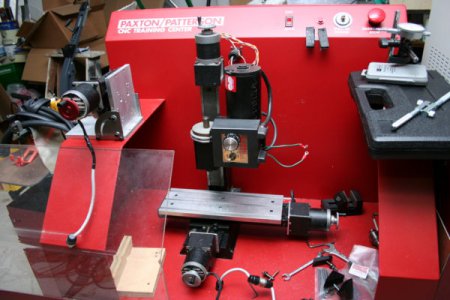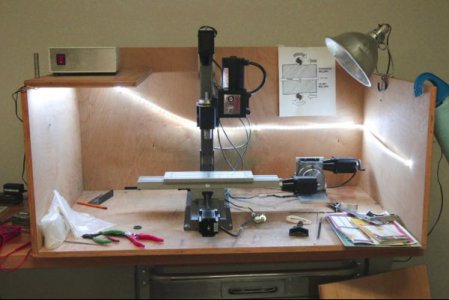OK. Set your clocks back to 2003. I was one of those guys who always kept saying "one of these days" I wanted to get a lathe and into metal working. My wife solved that for me and gifted me a
Sherline 4400 micro lathe for Christmas. I had never actually touched any machine tools at all at that point, so to say I didn't know jack is an understatement. After playing with that lathe for 6 months, learning how to make some chips, and reading the
Yahoo Sherline group regularly, an ad appeared for a CNC Sherline mill surplussed from a school system across the state in Tampa. After a 350 mile round trip drive, and handing the guy $300, I moved a CNC Sherline mill into my garage. The only problem was that nothing about it worked, except that the spindle motor turned. Like my lathe on its first day, this was the first time I had ever touched a milling machine.
The CNC Sherline was a Paxton Patterson CNC Training Center used in the VoTech programs there. It was in a cabinet with the electronics inside the box. From the outside, I could see that Mr. Cutter had been introduced to Mr. Table a few times, and it had a lot of machinable wax residue on it. I quickly found the major problem, though, and maybe why it was sold as surplus. The interface looked like a printer port but it wasn't. It only plugged into a special matching card made by the people who made the controller electronics. When a standard printer port was hooked up to the port, it blew a fuse on the power supply, and that's the way I got it. Once I figured that out, and wired a special connector, I found that two out of three axes didn't work. The Y-axis wasn't moving right and Z didn't move at all. The motor mounts on X were pretty barfed up, too. I had found the old DOS program TurboCNC and used that to issue commands to move the mill around.
The next several months were spent learning how CNC worked. Fixing electronics is my "home field", but I didn't have documentation on that motor controller. The motor mounts were threaded 1/2" aluminum bar, and I could make those. I eventually got it working, but I had to replace the controller with a Xylotex 3-axis board. A new Sherline CNC mill was close to $2000, and I only put another $200 into it to get it working right, so I had a CNC mill for $500. By this time, it was looking like this.

As the years went by, I expanded its capability. You can see that I added a fourth axis (
rotary) pretty early on (upper left on the angle bracket), and then upgraded the basic machine with the
A2ZCNC extended X/Y axes and a longer (15") Sherline Z axis. The stepper motors were upgraded in torque substantially, from 75 in-oz to almost 400. It no longer fit in the little red box, so I built a plywood enclosure for it, to contain chips somewhat. The current mill looks like this:

In 2008, I decided to build a CNC lathe. I bought the Sherline CNC-ready lathe, added motors, controllers, made cables; did all that stuff. I had gotten used to using the manual lathe by just walking up to it, chucking up a piece of work and doing what I needed to do. I told my wife that I'd leave both lathes on the bench for a while and whichever got used more would be the one we keep. We ended up keeping both. I wanted to use the CNC lathe to thread and that was a bit difficult, but it eventually did. I hardly used the CNC lathe once I got it to thread. I do virtually everything on the manual lathe. (I've got to admit, though, power feed is a pretty nice thing to have.) I have some pens I want to make, and the CNC lathe power feed will be handy for that.
My mill has always been CNC. I've never used it in a fully manual mode like I have the lathe. CNC is fantastic for never losing count of where it is, although it sure can get lost if the motor drops steps. It never loses concentration and goes too far. CNC has two main uses: first, running many copies of the same part, rather than one part made one time, and second, it's absolutely indispensable for really complex shapes even if it's just one thing. CNC mills have become the standard way the jewelry industry carves waxes to cast in the lost wax casting process and that was my original interest. I carved a lot of waxes with it, but never cast any.
I quickly found that some of the waxes I wanted to carve would take hundreds of thousands of lines of code. They choked TurboCNC and that's when I found Mach3. Been using Mach3 since '07. Today, I have a Warp9 Ethernet Smooth Stepper connected to the G0704, Sherline Mill and Sherline Lathe. I haven't run any Gcode files that long since '08 or '09, though.
I built all the parts for my G0704 conversion on the Sherline, including milling the oil grooves in the cast iron table. I think that 10 pound chunk of metal was too big for it, because right after that it started losing steps and I had to rebuild the X-axis leadscrew mount. I've built a ton of little metal odds and ends on the Sherline and have more accessories for it than the big 0704. Still, though, it's a good little mill when you stay in its envelope.



